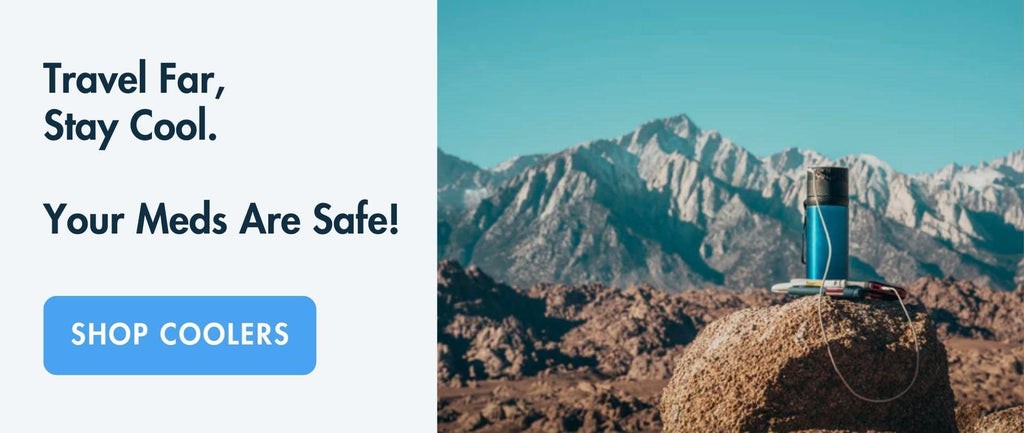Traveling with injectable medications requires careful consideration, especially when it comes to understanding Transportation Security Administration (TSA) regulations regarding needles and syringes. Whether you rely on medications like Insulin, Ozempic, Zepbound, Wegovy, Mounjaro, Humira, or Epipens, this guide provides essential information to ensure smooth and safe travels.
We’ll delve into TSA rules, packing advice, and specific scenarios like traveling with refrigerated medications. This guide addresses common questions such as:
- What are the TSA rules regarding injectable medications?
- Is it permissible to bring needles or syringes on a plane?
- What are the guidelines for preloaded syringes?
- How should injections be packed in carry-on luggage?
- What is the proper procedure for flying with refrigerated medications?
- Which syringe travel cases are TSA-approved for air travel?
TSA Regulations for Flying with Injectable Medication
The TSA is responsible for maintaining security standards for air travel in the United States, which includes thorough screening of passengers and their luggage. Understanding TSA regulations is critical for individuals traveling with injectable medications.
Liquid Medication Regulations for Air Travel
Injectable medications fall under the category of liquids, but they are exempt from the standard TSA liquid restrictions, meaning that the 3.4-ounce (100ml) restriction does not apply.
According to the TSA, passengers must inform TSA officers about any medically necessary liquids and place them in a separate bin for X-ray screening. While there are no restrictions on the quantity of liquid medication, TSA may require justification for amounts exceeding 3.4 oz/100ml, such as a prescription or a doctor’s letter indicating dosage. A return ticket can also help to justify the quantity of medication needed for the trip.
While not always requested, it is advisable to have the necessary documentation available to prevent potential delays.
Essential Documentation for Traveling with Injectable Medications
For domestic flights, carrying documentation is not required, but it can facilitate the security process to carry the following:
- A copy of your prescription.
- Medications should be clearly labeled.
- A TSA Notification Card For Individuals With Disabilities And Medical Conditions.
When traveling internationally with injectable medications, more comprehensive documentation is typically needed due to differing regulations. Prior to departure, research specific requirements of your destination country. You should carry:
- Medical prescription: Specifies the medication, dosage, and necessity.
- Doctor’s letter: Explains the necessity of the medication, especially for narcotics or controlled substances.
- Prescription labels: Clear and intact on all medication packaging.
- Proof of medical travel insurance: To cover any medical emergencies that may arise.
- Translation of the documents: Having translations of your medical documents can prevent misunderstandings.
Airport X-Rays and Medications: What You Need to Know
In general, airport security screening machines like X-rays and metal detectors do not affect most medications, including injectable medications. The radiation levels produced during a security scan are low, and the exposure duration is short—not enough to damage the medications.
However, if concerned, travelers have the right to inform the TSA officer if they do not want their liquid medication to be screened by X-ray or opened.
Those with electronic medical devices, such as insulin pumps, should exercise more caution.
- Consult the device manufacturer to confirm whether the specific model can safely pass through airport X-ray machines or metal detectors.
- Notify TSA agents if carrying such devices.
- Request a manual pat-down search.
Can You Bring Needles and Syringes on a Plane?
Needles, syringes, and injection pens are essential for administering injectable medications, and they are allowed on planes if packed properly.
Guidelines for Unused Needles on a Plane
Unused needles and syringes are permitted on a plane when accompanied by the corresponding injectable medication. Securely pack them to prevent accidents and simplify the security process. Declare your unused needles and syringes at TSA security checkpoints, typically by placing them visibly in a bin. Formal documentation is not usually required.
Guidelines for Used Needles on a Plane
When traveling with used needles and syringes, they must be transported in an FDA-approved sharps disposal container. If a sharps container is unavailable, a sturdy, hard-surfaced closed container can be used. Like unused items, used needles and syringes should be declared at TSA security checkpoints by placing them visibly in a bin.
Never dispose of used sharps in airplane lavatories or trash bins. Always plan for proper disposal at your destination.
While these are the guidelines, TSA officers are familiar with injectable medications and may not scrutinize the supplies too closely. However, you should always adhere to TSA guidelines and be prepared to provide explanations if asked.
Flying with Preloaded Syringes
When flying with preloaded syringes, each syringe must be clearly labeled to allow TSA agents to quickly identify the medication.
Syringes pre-filled by pharmaceutical manufacturers are typically labeled on the syringe or packaging. Ensure these labels are visible.
If you preload your syringes with medication at home, clearly label each syringe with the medication’s name and dosage. Bring the vial of medicine so the TSA officer can identify it.
TSA agents must easily ascertain the medication inside your syringe. Carry the original prescription or a doctor’s letter that matches the label.
Packing Injections, Needles, and Syringes in Your Carry-On
Packing your injectable medications, needles, and syringes in your carry-on luggage is recommended. While permitted in checked luggage, doing so is not advisable.
The cargo hold can experience temperature fluctuations and pressure changes that can affect your medication. Additionally, checked luggage can be lost or delayed. Carry your medications in your carry-on to ensure they remain intact and accessible.
Essential Packing Tips for Flying with Injections
- Keep the original packaging: When possible, keep your injectable medications in their original packaging with clear labels to help with identification by TSA agents and customs officials.
- Always bring spare supplies: Pack more medication, needles, and syringes than you anticipate needing in case of travel delays or extended stays.
Traveling with Injectable Medication that Needs to Be Refrigerated
Most injectable medications, such as insulin, Zepbound, Ozempic, Mounjaro, Wegovy, Humira, and Trulicity, need to be refrigerated or protected from heat. Special considerations and TSA rules apply to carrying ice packs and travel coolers to ensure these medications remain effective.
TSA Guidelines for Medical Cooling Cases
According to TSA regulations, ice packs, freezer packs, and gel packs may be presented at the screening checkpoint in a frozen, partially frozen, or melted state to keep medically necessary items cool.
 TSA approved medication coolers
TSA approved medication coolers
Medical-grade travel coolers are designed to keep injections refrigerated, even on long flights, and are TSA-approved.
TSA-Approved Medication Coolers
Travel cases for syringes and injections are designed to meet TSA requirements for airport security checkpoints and ensure the injections are safe and accessible. They come in a range of cooling cases to suit various medication needs, some with USB-powered cooling technology and others using biogel packs or evaporative cooling. Options range from compact cases for a single syringe to larger ones for extended trips.
By understanding and following these guidelines, you can confidently travel with your injectable medications, needles, and syringes while ensuring a smooth security experience and protecting your health.
